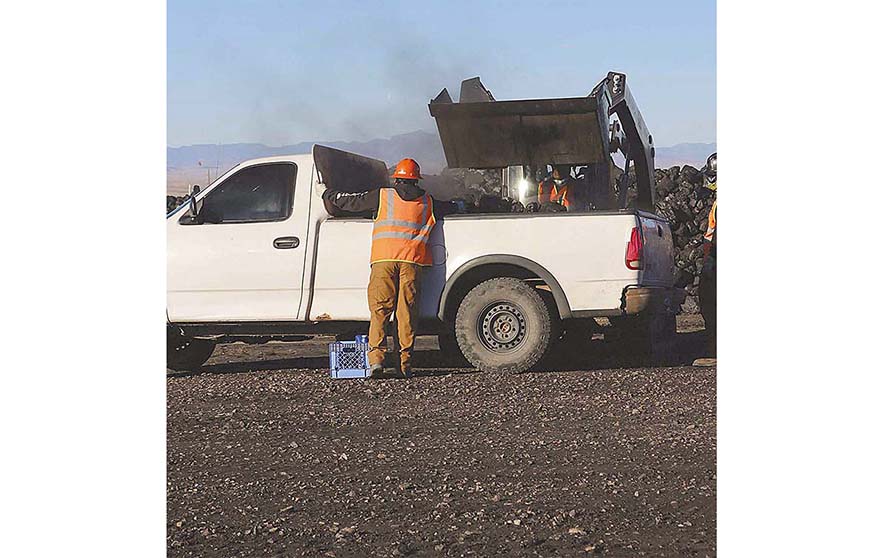
‘Navajo coal going to Navajo homes’: NTEC offers free coal to Navajo people at Navajo Mine

Navajo Times | Boderra Joe
Contractors at Navajo Mine help load a ton of coal into a community member’s truck during the opening day of the Navajo Transitional Energy Company free coal program on Oct. 25 in Farmington.
FARMINGTON – Free coal is available to all members of the Navajo Nation all winter, provided they can haul it away themselves.

Navajo Times | Boderra Joe
Skid steer loaders help the Navajo Transitional Energy Company free coal program by cutting loading time for everyday vehicles during opening day on Oct. 25 at Navajo Mine in Farmington.
The Navajo Transitional Energy Company, which two years ago became the first tribally owned coal mining company to operate a mine on tribal land, launched its annual Community Heating Resource Program on Oct. 25.
The program, which distributes vouchers to all Navajo Nation residents through their local chapters, will run through March 30, 2024, at Navajo Mine, about 20 miles southwest of Farmington.
Navajo Transitional Energy Company’s CHRP opened its 2023-24 season to provide free coal at the Navajo Mine for the entire Navajo Nation, including some Hopi residents.
The Navajo Mine opened in 1963 and has been distributing free coal to the neighboring Navajo chapters since the 1980s. For decades, because other mines were operational throughout the Navajo Nation, it mainly served only local chapters. When the Kayenta Mine in the northeastern corner of Arizona closed in 2019, NTEC realized that the Navajo Mine would need to be able to serve all 110 chapters of the Navajo Nation.
“I don’t think a lot of people realize how important coal still is for a lot of our Navajo families,” said Kay Nave-Mark, NTEC’s community engagement specialist, who has been at the company for 13 years and grew up in Fort Defiance. “We have people that come from all across the Navajo Nation. Like this morning, we had two families come from Black Mesa (nearly 500 miles to the west).”
Coal is a primary fuel source for Navajo residents who live in rural areas and do not have regular access to gas or electricity. Also, for those people who live in regions with few trees, coal is a necessity. Plus, coal burns longer than wood.
“Those people probably depended on Kayenta coal,” said Nave-Mark, “and now that we opened up the mine to the whole Navajo Nation, this is where they’re getting their heating.”
Eligible current or retired employees of NTEC or the Four Corners Power Plant are also entitled to a book of tickets for free coal. This applies even if they do not burn coal themselves but can share it amongst their families.
“Depending on the size of the chapter, larger chapters obviously get more tickets, or if it’s a chapter that uses, in the past, has used a lot of coal, we’ll give them more tickets,” said Andy Hawkins, NTEC training and community relations senior manager.
With the redesign, the program has a much safer and quicker loading approach for residents.
There are some safety measures to consider if traveling to the mine: double-check that the bed of your truck is clear, stay in your vehicle for safety reasons, and have a functioning tailgate to open and close, which CHRP stresses.
“It’s really awful for someone to drive from Bodaway Chapter, get here, and find out they don’t have a tailgate, and they can’t get their coal,” Nave-Mark said.
Redesigned and improved
From serving 30 vehicles per hour, the program can now serve upward of 175. A primary reason is the addition of skid steer loaders to scoop and load vehicles, which allows one ton of coal to be loaded in under two minutes.
The program also delivers 20 tons of coal to all 110 chapters upon request from the chapter. According to an NTEC press release, CHRP distributed more than 16,000 tons of coal and made 184 bulk deliveries to 84 chapters.
“One of the most important things that is really cool about working here is meeting a lot of the people that come through, especially the people that come very far to get coal,” said Nave-Mark. “I don’t think a lot of people realize how important coal still is for a lot of our Navajo families. We have people that come from all across the Navajo Nation. Like this morning, we had two families come from Black Mesa.
“Those people probably depended on Kayenta coal, and now that we opened up the mine to the whole Navajo Nation, this is where they’re getting their heating,” she said.
Miss Navajo Nation Amy Naazbah Reeves-Begaye joined the opening ceremony, adding that it was an important day for her to visit the Navajo Mine for the first time.
Reeves-Begaye shared that her family uses coal and said they used to gather coal at the Black Mesa mine. But since that mine is now closed, they had to seek alternatives.
“Not a lot of our elderly are very fortunate to have relatives who are willing to take the time to bring them coal,” Reeves-Begaye said. “I was pretty proud of Navajo Mine and NTEC to do those type of services.”








 Highway 264,
Highway 264, I-40, WB @ Winslow
I-40, WB @ Winslow